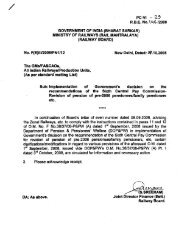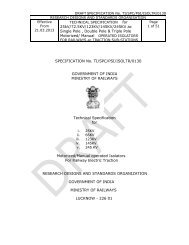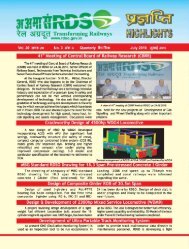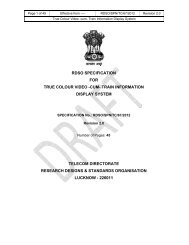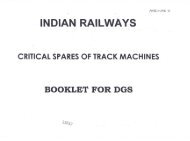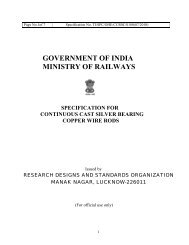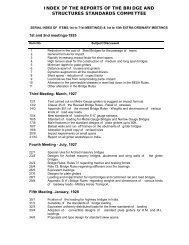Tender invited for Development of Train Collision Avoidance System
Tender invited for Development of Train Collision Avoidance System
Tender invited for Development of Train Collision Avoidance System
Create successful ePaper yourself
Turn your PDF publications into a flip-book with our unique Google optimized e-Paper software.
ISO 9001: 2008 Effective from 18.06.2012 RDSO/SPN/196/2012 Version 3.1.1<br />
Document Title : Specification <strong>of</strong> <strong>Train</strong> <strong>Collision</strong> <strong>Avoidance</strong> <strong>System</strong><br />
the speed by application <strong>of</strong> the Full Service Brake and/ or emergency brakes<br />
in collision like situations or as the case may be.<br />
5.8.6 It shall be possible to test the working <strong>of</strong> all brake valves <strong>of</strong> Brake Interface<br />
Unit (BIU) in stationary condition <strong>of</strong> the train by pressing Manual Brake Test<br />
(MBT) button by the Loco Pilot. The MBT shall be possible to be initiated<br />
through a s<strong>of</strong>t key on the OCIP.<br />
5.8.7 The braking logic <strong>of</strong> the Loco unit shall be so intelligent that based on the<br />
default or assessed brake characteristics <strong>of</strong> the train and depending upon the<br />
speed <strong>of</strong> the train, gradient <strong>of</strong> the location & the target, Loco unit shall decide<br />
which type(s) <strong>of</strong> brake & when to be applied to stop the train short <strong>of</strong> safe<br />
distance or control the speed to desired value be<strong>for</strong>e target without frequent<br />
repeated braking. In case the distance available between the two trains at the<br />
instance <strong>of</strong> perceived danger is not adequate, Loco unit shall apply maximum<br />
brake to reduce the speed <strong>of</strong> the trains as much as possible under the<br />
circumstances so that impact is minimized.<br />
5.8.8 Design <strong>of</strong> the Loco unit equipment shall be such that its braking interface unit<br />
can be isolated by the Loco Pilot when so warranted. The isolation <strong>of</strong> braking<br />
interface shall be communicated to the Centralized Management <strong>System</strong>. To<br />
deter its incorrect use, the isolation mechanism must be protected and<br />
isolation <strong>of</strong> braking interface must be recorded. Also, the message about such<br />
isolation shall be displayed on Loco Pilot’s OCIP to in<strong>for</strong>m Loco Pilot about<br />
isolation <strong>of</strong> TCAS. Isolation <strong>of</strong> TCAS/BIU shall not affect existing brake<br />
characteristics <strong>of</strong> the loco/other self-propelled vehicles. Traction cut <strong>of</strong>f<br />
feature through TCAS shall also be isolated under such events.<br />
5.8.9 In order to control the train speed to a particular ceiling limit with reference to<br />
a location or to stop the train with reference to a location or prevent collision,<br />
Loco unit shall intelligently take decision about type & location <strong>of</strong> brake<br />
application based on the speed <strong>of</strong> the train, distance from the target, brake<br />
characteristics <strong>of</strong> the train (assessed or default) etc. so that train speed is<br />
controlled or train is stopped, as the case may be, within a safe distance <strong>of</strong><br />
200m from the target. In case <strong>of</strong> Stop Signals at ON, it shall stop close to the<br />
signal with safe front end <strong>of</strong> the train within 50m on approach to the signal.<br />
5.9 Track Identification Number (TIN)<br />
5.9.1 Each track shall have designated Track Identification Number (TIN).<br />
5.9.2 Each straight track shall have single unique designated TIN end to end i.e.<br />
from block section to station section then to block section. Each line in the<br />
station section having berthing portion shall have different TINs.<br />
5.9.3 The TINs used <strong>for</strong> loop lines at a station can be reused on other stations.<br />
5.9.4 Prior to start <strong>of</strong> TCAS territory, arrangements shall be provided to allocate TIN<br />
<strong>of</strong> that track to Loco unit be<strong>for</strong>e it enters the TCAS territory.<br />
5.9.5 Further, inside the TCAS territory, Loco unit shall be able to self-deduce the<br />
change in its TIN whenever it changes the track after negotiating the point<br />
zones. For this purpose duplicated RFID tags shall be provided at each entry/<br />
exit <strong>of</strong> each point, at entry/ exit <strong>of</strong> each station section and at not more than<br />
1000m interval in block section.<br />
5.9.6 There shall be no case <strong>of</strong> assignment or deduction <strong>of</strong> wrong TIN by Loco unit.<br />
5.9.7 In exceptional cases <strong>of</strong> incorrect track identification number by a Loco unit, it<br />
shall go to ‘Controlled Mode’.<br />
5.9.8 After the train leaves TCAS territory, Loco unit shall enter into Unfitted mode<br />
automatically. The driver shall be asked to acknowledge the transition. If the<br />
driver does not acknowledge within 5 seconds, a service brake command<br />
shall be initiated. The driver shall then acknowledge the level transition in<br />
order to release the service brake command.<br />
Signal Directorate RDSO/Lucknow Page 18 <strong>of</strong> 56


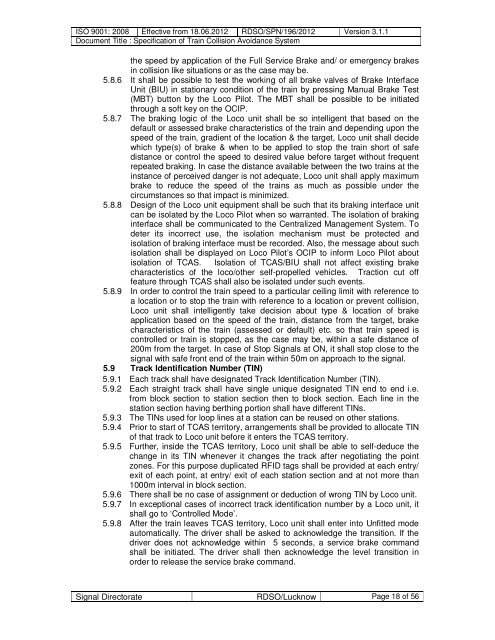
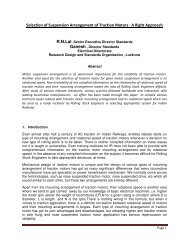

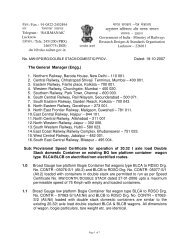
![Hkkjrljdkj] jsy ea= ky; vuql a/ kkuvfHkdYivkSj ekudlax Bu y ... - rdso](https://img.yumpu.com/21978459/1/184x260/hkkjrljdkj-jsy-ea-ky-vuql-a-kkuvfhkdyivksj-ekudlax-bu-y-rdso.jpg?quality=85)

